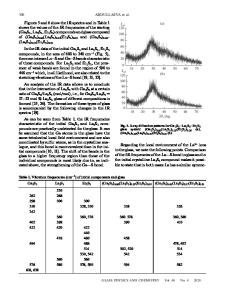Cation-adsorption-assisted Ni 3 S 2 /carbon nanowalls composites with three-dimensional interconnected porous structures
- PDF / 5,969,744 Bytes
- 13 Pages / 595.276 x 790.866 pts Page_size
- 8 Downloads / 394 Views
Cation-adsorption-assisted Ni3S2/carbon nanowalls composites with three-dimensional interconnected porous structures for high-performance lithium-ion battery anodes Hai-Jun Chen1, Yan Wang1,*, Xu-Dong Ma2, Cong Fan1,* Shi-Wo Ta3, Hai-Bin Wu3, and Zhe-Sheng Feng1,*
, Pei Kang Shen2,
1
School of Materials and Energy, University of Electronic Science and Technology of China, Chengdu 610054, People’s Republic of China 2 Collaborative Innovation Center of Sustainable Energy Materials, Guangxi University, Nanning 530004, People’s Republic of China 3 State Key Laboratory of Advanced Materials and Electronic Components, Guangdong Fenghua Advanced Technology Holding Company Limited, Zhaoqing 526000, People’s Republic of China
Received: 7 May 2020
ABSTRACT
Accepted: 30 August 2020
Metal sulfide/carbon composite reveals to be a prospective electrode material for lithium-ion batteries due to the synergy of the two components, and their structure greatly determines the electrochemical performance. We herein have successfully fabricated an in situ encapsulation of Ni3S2 nanoparticles into carbon nanowalls (Ni3S2/CNWs) with three-dimensional interconnected porous structures, which are synthesized assisted by cation adsorption and following hydrothermal process. The abundant mesoporous carbon nanowalls are used as both conductive matrix and protective layer to alleviate the volume change of Ni3S2. Benefiting from the superior theoretical capacity of Ni3S2 and unique structure of CNWs, Ni3S2/CNWs-1 anodes show the high discharge capacity of 906 mAh g-1 at 200 mA g-1 after cycling 200 times, outstanding rate capacity of 567 mAh g-1 at 5 A g-1 and super-long cycling life of 666 mAh g-1 at 2 A g-1 after cycling 1000 times. More importantly, the button-type full cells based on Ni3S2/CNWs-1 anodes and LiFePO4 cathodes present excellent cycling stability and practicality.
Published online: 22 September 2020
Ó
Springer Science+Business
Media, LLC, part of Springer Nature 2020
Handling Editor: Mark Bissett.
Address correspondence to E-mail: [email protected]; [email protected]; [email protected]
https://doi.org/10.1007/s10853-020-05203-3
17082 Introduction Lithium-ion batteries (LIBs) have been proved to be the main power source for portable electronic devices and hybrid electric vehicles due to their advantages of high energy density, long cycling life and environmental benignity [1–3]. Nevertheless, the theoretical capacity of commercialized graphite anode is just as low as 372 mAh g–1, which leads to the fact that the presently available LIBs are unable to further satisfy the requirements of large-scale energy storage [4, 5]. Consequently, considerable efforts have been devoted to develop the innovative anode materials for high-performance LIBs. Nowadays, transition metal sulfides, such as Ni3S2, NiS, NiS2, CoS2 and Co9S8 [6–9], have been regarded as possible candidates and attracted tremendous attention due to their multistep reversible redox reactions, which provide high theoretical capacity by making full use of all oxi
Data Loading...











